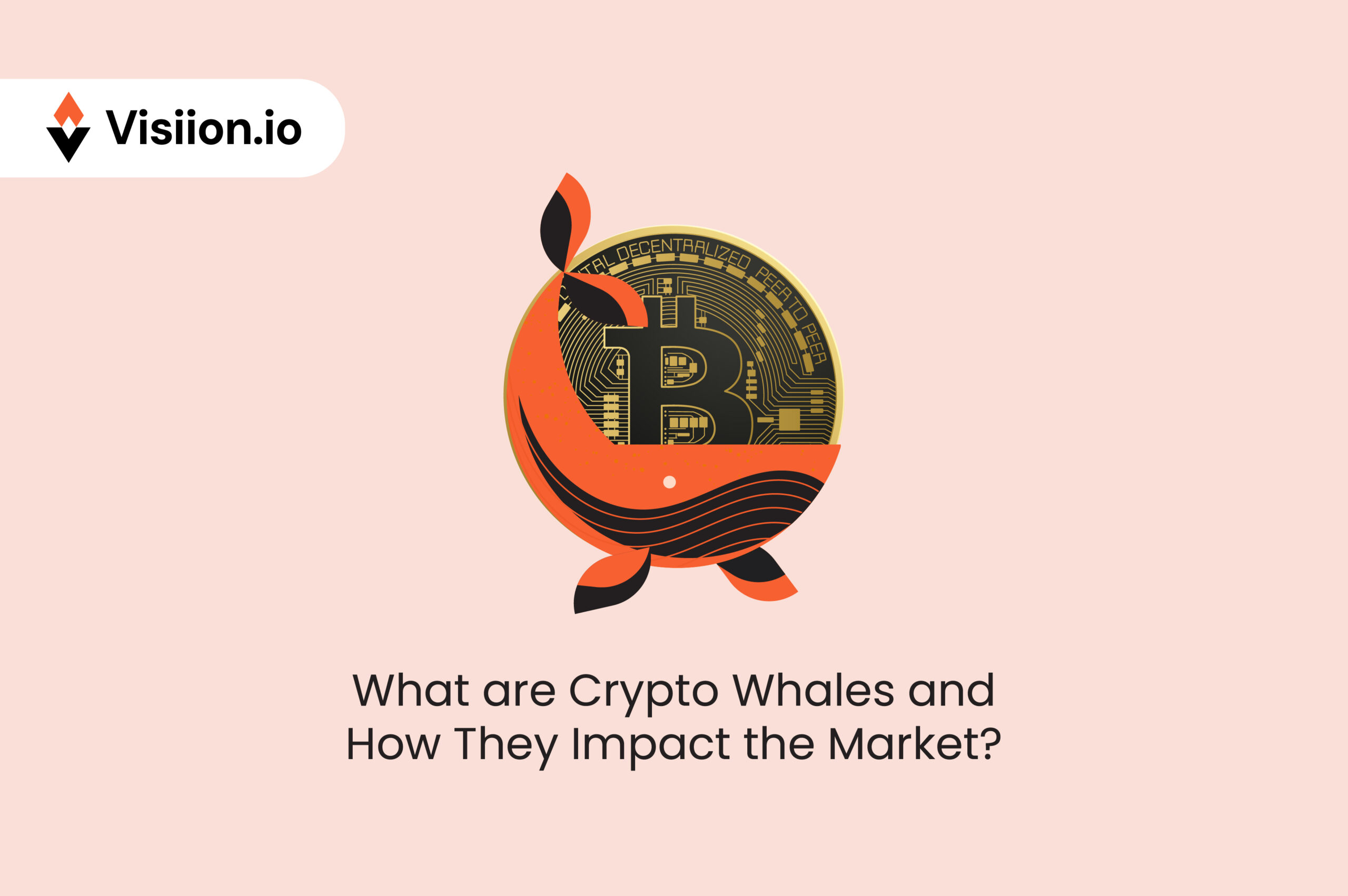What are Crypto Whales and How They Impact the Market?
If you are dealing with cryptos, you must have heard the term “crypto whales.” But have you ever wondered, who are these crypto whales? How they influence the crypto market and how retail traders can deal with them? Well, you’ll find your answer in this blog.
In this blog, we will share some interesting (and even surprising!) information about crypto whales. We will also break down how you can identify crypto whales and, most importantly, whether you should follow them. So, without wasting much time, let’s get started. But first, let’s get some basics
Who are Crypto Whales?
Crypto whales are individuals, institutions, or entities that have a large amount of a particular crypto in their wallets. Each cryptocurrency has some whales. These individuals or institutions have a massive ability to influence that particular crypto’s price just because of their massive holdings. You’ll find such crypto whales in almost every cryptocurrency.
While manipulating big cryptos like Bitcoin and ETH is a bit difficult, certain crypto whales exist who can push their prices up and down. The reason is pretty simple: they have massive holdings of these cryptos. As they can execute big trades, they can directly impact the balance between supply and demand. If they buy big, prices shoot up, and if they sell big, prices come crashing. So if you are a responsible trader or investor, you would definelty want to consider crypto whale’s influence in your strategies
How Much Crypto Do You Need to Be a Whale?
Now, this is where the debate rages on! To be honest, there is no fixed consensus on what makes someone or an institution a crypto whale. But it’s generally agreed that anyone who is holding 1,000 or more BTC is a crypto whale of Bitcoin. Similarly, anyone who is holding 5,000 or more ETH is an Ethereum whale. The same goes for other cryptos and altcoins, depending on their valuation and market cap.
How Crypto Whales Impact Market Dynamics?
Now, this is where it gets interesting for traders and investors. As they have a large cache of a particular crypto, they can dictate the short-term market trends and conditions. For traders, there is a silver lining in there.
As these large-scale transactions create a pattern in the price movement, traders can use the pattern to predict future price action. As we all know, crypto markets are highly volatile, and whale activities impact the price movement a lot. Here’s how:
1, Liquidity Shifts
When a crypto whale makes a big transaction, it can easily disrupt the entire balance of supply and demand. A single large transaction from a whale can disrupt the balance of supply and demand.d Moreover, their activities can impact the market liquidity. Let’s say if a whale moves a big portion of their BTC or ETH to an exchange from the wallet; it means they are planning for a potential sell-off. Similarly, if a whale moves their BTC or ETH from an exchange to a cold wallet, this means they are planning to sit on it. This might indicate a potential upmove or stable prices. Most importantly, if the market has good liquidity, even a small movement of cryptos can cause disproportionate price swings
2, Market Sentiment
Whales hold the power to alter the market sentiment. How? Well, it’s pretty simple. A lot of retail traders follow crypto whales. And whenever these whales make a move, retail traders react strongly. More often than not, these retail moves are irrational.
For example, if the famous crypto whale starts gathering crypto, retail traders face FOMO. This FOMO makes them buy more and push the asset’s price up. On the contrary, if a crypto whale dumps a big chunk of any crypto, retail traders begin panic selling. This causes a sharp drop in the asset’s price. As the crypto market is quite speculative, even the rumours about whale transactions trigger reactive behavior.
3, Price Manipulation
While this is uncommon amongst popular coins like BTC and ETH, the practice prevails, especially in less popular cryptos. For example, whales deploy a method called “spoofing.” Here, they place a massive buy or sell order. This creates a fake demand or supply. Result? Retail traders jump the gun and go in the direction of the crypto whales.
Another common strategy is known as “rinse and repeat.” Here, crypto whales slowly accumulate target crypto slowly. Once they have enough, start a “pump” via market hype. Retail traders jump in, buy the crypto, and push its price higher. Then, all of a sudden, whales “dump” their stake at the upper price band. This causes the price to plummet, and retailers lose money. Once the price is down, crypto whales repeat the strategy again, and traders fall into the same trap again!
Crypto whales make big profits in these cycles, while retail trade loses money. So it’s very important for retail traders to use their own brain while dealing with crypto whales. But first, retail traders need to identify crypto whales.
Let’s understand how.
How to Spot a Crypto Whale?
The retail crypto traders here have an edge. All the blockchain transactions are public. So, anyone can track them; traders depend on various platforms and methods to track whales.
1, Whale Alert Services
There are a lot of tools that can help you track big crypto transactions. For example, you can use Whale Alert to track these transactions in real time. These services scan the entire blockchain activities and flag big transactions of the most popular cryptos. A lot of traders use this method to anticipate market movements based on whale behavior.
2, Order Books and Exchange Data
Another way to track crypto whales is to track exchange order books. These order books can easily reveal big whale activities. For example, if there is a big buy or sell order, it might be an indication that the price might go up or down significantly. Also, the sharp change in the trading volumes indicates big price movements as they are the result of big whale activities.
3, Social Media and Forums
Some whales communicate their strategies or market outlook through platforms like X, Telegram, and Discord. If you are following such crypto whales, you might get an insight into these whale activities. But remember, not all the information you find on social media is reliable. Even the genuine whales love to play tricks with their retail followers. So, make sure you don’t use social media information as the sole source of your trading.
How Do Crypto Whales Stay Anonymous?
Despite the transparency of blockchain transactions, whales employ multiple tactics to conceal their identities and holdings:
- Multiple Wallets:- Whales split their funds across numerous wallets to avoid detection.
- Privacy Coins:- Some move funds into privacy-focused cryptocurrencies like Monero to obscure their transactions.
- Over-the-Counter (OTC) Trading:- Instead of using public exchanges, whales trade privately through OTC desks to prevent market disruption.
- Layering Transactions:- They distribute transactions across different wallets and exchanges, making them harder to trace.
- Custodial Services and Trusts:- Institutional whales often store assets through custodial firms or trusts, shielding their identities.
The Biggest Crypto Whales in the Market
Some of the most influential crypto whales include:
- Satoshi Nakamoto:- The legendary creator of Bitcoin. They hold almost 1.1 million BTC in their wallet. This makes them a largest whale in the market.
- MicroStrategy:- It’s a publicly traded company and holds more than 499,000 BTC in their account.
- Tesla:- Elon Musk’s company is a big whale to. It holds a large number of BTC in their reserve.
- Exchanges and Institutional Funds:- Binance, Coinbase, and hedge funds also hold a big number of cryptos in their wallets. This makes them big crypto whales.
- Government Holdings:- A lot of government holds sizeable number of Bitcoins. Most of them are from the ones they have seized in the criminal cases.
Should Traders Follow Whale Movements?
There is a difference between tracking a whale’s activity and trading solely based on those activities. Whale movements can give you a quick insight into the market trend, liquidity flow, and even price direction in some cases. However, the problem is that crypto whales often tend to manipulate the market for their gain. So, you should not react impulsively based on the whale activity.
We’ve seen numerous examples where whales create a positive or negative sentiment in the market to offload their stakes. So make sure whatever you do, you do it after anlayzing your decision in multiple ways.
How Crypto Wahles behave in Bull and Bear Markets?
Crypto whales’ behaviors are quite different during different market cycles. For example, they create an artificial demand for crypto in the market. As the market is already in the bull run, retail traders often take this pump as an overall market phenomenon. And once the prices reach their desired level, they dump their entire stake.
In bear markets, they play with the panic. They offload their stakes and create panic. Once the price dips below certain level, they start accumulating the asset at lower price. This helps them enter early when others are selling.
If the market is going sideways, whales test liquidity with sporadic large trades. This causes short-term loquidty in the market.
In short, crypto whales perform activities that allow them to buy at lower prices and sell at higher. It doesn’t matter what market they are in, they often end-up making money.
Strategies to Deal with Crypto Whales
Now comes the interesting part. Retail traders do not have much capital when compared to crypto whales. So, it’s important that they take certain steps to deal with crypto whales.
- Diversification:- Avoid overexposure to a single asset to minimize risk.
- Tracking On-Chain Data:- Use blockchain analytics tools to monitor whale activity in real-time.
- Using Stop-Loss Orders:- Protect against unexpected price drops caused by whale sell-offs.
- Avoiding Emotional Trading:- Reacting impulsively to whale movements can lead to losses.
- Following Market Trends, Not Just Whales:- While whale tracking is useful, macroeconomic trends and fundamental analysis should guide investment decisions.
The Future of Whale Influence in Crypto Markets
Whale dominance in crypto markets is unlikely to disappear. However, as adoption increases and more liquidity enters the market, individual whale influence may decline. The rise of decentralized finance (DeFi) and broader institutional participation could lead to more distributed market control.
Conclusion
Crypto whales are big players. So they obviously are an important part of the market. There is no harm in tracking their activities. But we strongly recommend that you don’t just rely on crypto whale activities. They could be deceptive sometimes. And sometimes, even the big crypto whales make the wrong decision. To improve your knowledge, develop a powerful strategy, and stick to it. Trust your system, and you will be good to go.
We hope this blog has offered you enough information about crypto whales and their activities. If you like this information, you will find out other blogs helpful too. Feel free to explore.










